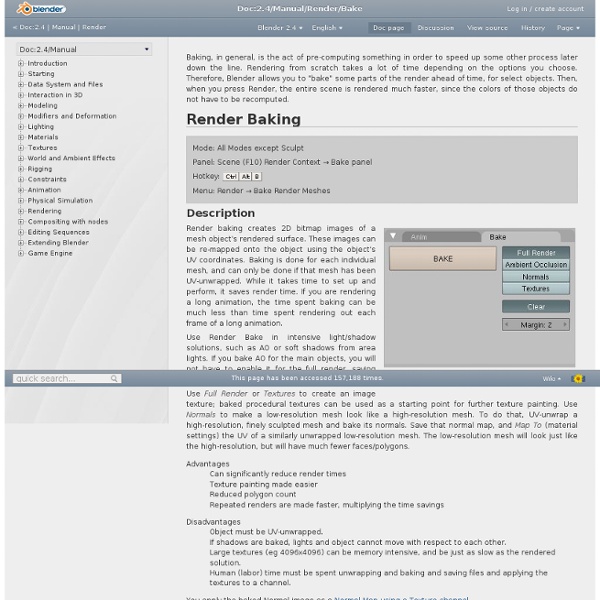Manual/Render/Bake

Blender 3D Design Course
Blender 3D Design Course Note: Added new Lesson #13 - NURBS Surfaces / Meta Objects - April 27, 2013 Note: Added new Lesson #14 - Rigid Body Dynamics- June 1, 2013 Students: This course is also available for downloading to your iPhone or iPad via Tufts University iTunesU. The video tutorials are also available on my Vimeo channel (Blender Video Tutorials - Neal Hirsig) Instructors: If you are an instructor and would like to download the 3D Design Blender 2.6X content (Syllabus, Video Tutorials, PDF Tutorials, Projects and Exercises), send me your name, e-mail address and the name of your school or institution. Neal Hirsig nhirsig@tufts.edu Syllabus Blender Cheatsheet Project 1A - Jewelry Project 1B - Robot Project 2A - The Way Things Work Project 2B - Wind Sculpture Project 3A - Architecture Project 3B - Reality 3D Project 4A - Animal Planet Project 4B - Set Design All Video Tutorials All PDF Tutorials Links Copyright Notice Attribution-NonCommercial-ShareAlike CC BY-NC-SA
Manual: Unity Manual
Unity is made to empower you to create the best interactive entertainment or multimedia experience that you can. This manual is designed to help you learn how to use Unity, from basic to advanced techniques. It can be read from start to finish or used as a reference. If you find that any question you have is not answered in this manual please ask on Unity Answers or Unity Forums. You will be able to find your answer there. For information about upgrading projects from Unity 4 to Unity 5, see our Upgrade Guide here. Overview This section is your key to getting started with Unity. Editor Working with the panels, tabs and views of the Unity Editor. Graphics The visual side of Unity including Cameras and Lighting. Physics Physics in Unity, including working with rigid bodies and manipulating them in 3D space. Scripting Programming your games by using Scripting in Unity. Audio Audio in Unity, including clips, sources, listeners, importing and sound settings. Navigation Architecture Platform Specific
Related:
Related:



